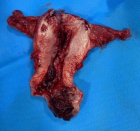Table of Contents
Neonatal Mortality Rate among Twin and Singleton Births with the Gestational Age of 34-37 Weeks: A Population-Based Study
Published on: 28th June, 2023
Introduction: Twin pregnancy, compared to a singleton pregnancy, is associated with a higher risk of preterm birth and other neonatal complications. This study aimed to compare neonatal mortality rates and risk factors among births with the gestational age of 34 weeks - 37 weeks in twin and singleton pregnancies.Methods: The study design was cross-sectional and population-based. We extracted the data from the birth information registry in Iran. Mothers' and neonates' information was removed from the registry systems between 2018 and 2020. We used Statistical R software to compare neonatal mortality rate, demographic variables, and risk factors between two groups of twin and singleton neonates.Results: Out of 579,873 live births with a gestational age of 34 weeks - 37 weeks, 729 (1.4/1000) singleton and 54(0.77/1000) twins (one out of two) neonates died in the delivery room in the first hour of life. Of the neonates who left the delivery room alive, 3129 (4.9 per 1000) neonates had died (5.7/1000 singleton and 3.04/1000 twin). The neonatal mortality rate in hospitalized singleton neonates (1.85%) was higher than twin group (1.06%). After adjustment of other variables, the mortality rate in twin pregnancy was significantly lower than in singletons (p value < 1/1000), with an odds ratio of 0.47 (CI: 0.39 - 0.55). Antenatal corticosteroid treatment in the twin group was significantly higher than in singletons.Conclusion: Twin neonatal mortality rate was lower than singletons in the neonates with gestational age 34 weeks - 37 weeks. Clinicians could consider these results for delivery timing in uncomplicated twin pregnancies. Antenatal corticosteroid therapy can be considered to reduce the mortality rate of late preterm neonates in resource-limited countries.
Amniotic Fluid Ischemia Modified Albumin as a Novel Prenatal Diagnostic Marker for Down Syndrome: A Prospective Case-Control Study
Published on: 21st June, 2023
Aims: There is no study in the literature about ischemia-modified albumin (IMA) and hepatocyte growth factor (HGF) levels in amniotic fluid for Down syndrome cases. The aim of this study was to investigate the changes of IMA and HGF in Down syndrome cases at 16-20 weeks of gestation compared to normal fetuses.Methods: For this prospective case-control study, following reaching the number of 20 women (study group) who had the prenatal diagnosis of Down syndrome, maternal and gestational age-matched pregnant women with normal constitutional karyotype were selected for the control group (n = 74) from the stored amniotic fluid samples. Results: Mean women and gestational ages were comparable between the two groups. Amniotic fluid IMA (1.32 ± 0.13 vs. 1.11 ± 0.11 ABSU, respectively, p < 0.001) and HGF (2743.53 ± 1389.28 vs. 2160.12 ± 654.63 pg/mL, respectively, p = 0.008). Levels were significantly higher in pregnant women having Down syndrome fetuses compared with women having normal fetuses. The amniotic fluid IMA levels for the diagnosis of Down syndrome, and the sensitivity and specificity were calculated as 95.0% and 71.6% for the limit value 1.171 cm3, respectively. Conclusion: In cases with suspected Down syndrome, the diagnosis of Down Syndrome may be made in approximately 1 hour with high sensitivity and specificity by measuring the IMA level in the amniotic fluid sample taken for fetal karyotyping.
Surgical Management of Uterine Fibroids at the Teaching Hospital of Angre Abidjan Cote d’Ivoire: 193 Cases Report
Published on: 20th June, 2023
Objective: To evaluate the surgical management of myomas at the Teaching Hospital of Angré according to the FIGO (International Federation of Gynecology and Obstetrics) classification.Patients and methods: This was a cross-sectional study at the Teaching Hospital of Angre from January 1, 2020, to December 31, 2022. Patients whose operative indication was clearly identified were included in the study. Incomplete files were not included. The variables studied were anthropometric parameters, clinical characteristics of myomas, and surgery. Due to the large size and multifocal location of uterine myomas, the therapeutic option remained surgery by laparotomy.Results: Most patients were over 35 years old (71.5%) and nulliparous (52.8%). The first indication for surgery was menometrorrhagia (88.6%), followed by the desire for motherhood (37.8%) and dysmenorrhoea (20.2%) for myomas most often FIGO type 4 (p = 0.0031). Myomectomy under cervical-isthmic tourniquet was the most common procedure for FIGO type 4 myomas (66.1%; p = 0.0543). Hysterectomy was most frequently performed for FIGO type 7 myomas (43.9%; p = 0.0543). For myomectomy, the first complication was anaemia (3.5%) followed by uterine suture haemorrhage (1.7%) (p = 0.5139).Conclusion: Our surgical practice at the Teaching Hospital of Angre is in accordance with FIGO recommendations. However, an effort should be made to promote the minimally invasive surgical approach (laparoscopic, hysteroscopic, transvaginal ablation) for small fibroids (≤ 5 cm) or FIGO type 0 to 3, which is not very frequent in our current practice.
Racial and Ethnic Disparities in Pregnancy-related Complications: Findings at Mansa General Hospital and 2nd Affiliated Hospital of Nanjing Medical University
Published on: 16th June, 2023
Background: 800 women die and 2.6 million stillbirths occur worldwide related to pregnancy complications. Racial/ethnic disparities in pregnancy-related mortality have continued to be significantly higher among black than whites due to various factors. We sought to investigate complications among pregnant women of different race/ethnicity.Methods: Cross-sectional observational study of 2030 obstetric cases randomly selected for the period January 1 to December 31, 2021. Data was collected from the hard copy and electronic inpatients’ records. Analysis was performed using SPSS version 23. Descriptive statistics analyzed the pregnancy complication frequencies, standard deviations, range, minimum and maximum values. Maternal characteristics were analyzed using an independent samples t-test. Maternal characteristics were evaluated using the two samples t-test. The odds ratios and confidence intervals were calculated as measures of association between ethnicity/race and pregnancy complications using a binary logistic regression model. Confidence interval was set at 95% and p < 0.05 (2-tailed) was considered statistically significant.Results: 76.25% of Chinese and 67.86% of Zambians were affected by one or more complications. The mean ± standard deviation for MGH [age (26.69 ± 7.33), gravidity (3.35 ± 2.08), and parity (2.07 ± 1.68)] and for 2nd affiliated hospital was [age (30.04 ± 4.29), gravidity (2.19 ± 1.38) and parity (0.45 ± 0.55)]. Prevalence of top five pregnancy complications in the Chinese group was gestational diabetes mellitus at 18.41%, hypothyroidism at 15.91%, oligohydramnios at 14.39%, premature rupture of membranes at 12.17%, and anemia at 5.73%. The prevalence of the top five pregnancy complications in the Zambian group was preeclampsia at 13.80%, PIH at 12.74%, PROM at 12.45%, eclampsia at 7.53%, and placenta abruption at 7.43%. Statistical significance findings were noted as follows: Oligohydramnios [OR 0.02, CI (0.01 - 0.05), p = 0.000], placenta praevia [OR 0.08, CI (0.01 - 0.61), p = 0.015], preeclampsia [OR 13.10, CI (7.22 - 23.78), p = 0.000], placenta abruptio [OR 79.73, CI (11.07 - 574.38), p = 0.000], PIH [OR 11.95, CI (6.57 - 21.73), p = 0.005], eclampsia [OR 162.90, CI (10.08 - 2631, p = 0.000), PPROM [OR 0.03, CI (0.00 - 0.45), p = 0.012], GDM [OR 0.11, CI (0.07 - 0.17), p = 0.000], hypothyroidism [OR 0.01(0.00-0.03), p = 0.000], anemia [OR 0.18, CI (0.92-0.34), p = 0.000], ICP [OR 0.03, CI (0.00 - 0.48), p = 0.013], syphilis [OR 7.17, CI (2.14 - 24.02), p = 0.001], UTI [OR 22.55, CI (3.04 - 17.26), p = 0.002], HBV [OR 0.05, CI (0.00 - 0.86), p = 0.039] and GBS [OR 0.06, CI (0.00 - 1.11), p = 0.059].Conclusion: Highest odds for obstetrical and infection-related pregnancy complications were associated with Zambian cases. The highest odds for medical complications were associated with Chinese cases.
Aseptic Meningitis in Pregnancy – A Case Study Detailing Potential Diagnostic Dilemmas
Published on: 14th June, 2023
There are few reported cases of meningitis in pregnancy and presentation can be variable in each patient which may cause diagnostic challenges and potential delays in treatment. Here, we discuss a case of aseptic meningitis - a 36 years old Gravida 2 Para 1 pediatric physician with “the worst headache of her life” at 31+5 weeks of gestation. At presentation, she did not have any of the classic triads of meningitis (fever, neck stiffness, and/or a change in mental status) and did not report any neurological symptoms. In view of persistent headache, development of pyrexia, and evolving symptoms of photophobia, she was referred to a neurology specialist, and a lumbar puncture was performed. Findings were in line with meningitis and the polymerase chain reaction confirmed enterovirus meningitis. Although aseptic meningitis is rare, it should be considered as a differential diagnosis in patients with persistent complaints, development of associated symptoms of pyrexia, photophobia, and neck pain, as well as in patients with increased risk of exposure to viral illnesses.
A baseline assessment of the knowledge, attitude, and practices of exclusive breastfeeding among women enrolled in a cluster randomized trial in Anambra State Nigeria
Published on: 8th June, 2023
Background: Exclusive breastfeeding has great benefits for both the mother and the child. Few studies have been carried out on interventions to improve Exclusive Breastfeeding (EBF) practice by childbearing mothers. No study has formulated and/or implemented a hospital-based maternal counseling guide intervention to improve EBF practice. This baseline study assessed the knowledge, attitude, and practice of EBF on mothers who were enrolled in antenatal clinics for a cluster randomized trial and the disparity in the knowledge of EBF based on lactation, age, sex, and source of income.Methods: We formulated a hospital-based counseling guide on exclusive breastfeeding, which is under implementation by prenatal and nursing mothers, to promote EBF practice in the study area. A cross-sectional study was conducted in two hospitals randomly selected from twelve hospitals in Anambra State. The study was among pregnant women who were in their second trimester. The data collection took place from March to April 2022. The data were analyzed using descriptive statistics and Chi-Square. The test of significance was set at p < 0.05.Results: The control and the intervention arms had an equal number of enrolees (144) each and more than half of the participants were between the ages of 23 – 32 years. The majority of the participants showed adequate knowledge of exclusive breastfeeding as over 90% knew that EBF is important and capable of improving their baby's immunity. The participants demonstrated a positive attitude to exclusive breastfeeding and they had a significantly high level of practice of daily consumption of galactagogues. The study suggested that the majority did not practice breast milk extraction mainly because the process of extraction is painful and some do not know how to carry out the extraction.Conclusion: The mothers have the requisite knowledge of the benefits of exclusive breastfeeding to their infants and themselves. However, they do not practice EBF. Interventions to improve EBF practice should focus on educating mothers on proper breast milk extraction and storage techniques.
Addressing reproductive healthcare disparities: strategies for achieving health equity
Published on: 8th May, 2023
Reproductive health care disparity is a significant public health issue that affects many populations. This disparity stems from various factors, including race, ethnicity, socioeconomic status, geographic location, and education level. Such inequality results in adverse health outcomes such as unintended pregnancy, infertility and sexually transmitted infections among certain populations. Therefore, addressing reproductive health care disparities requires increasing access to affordable and comprehensive reproductive health services, promoting culturally competent care, improving access to family planning services and addressing barriers to care. Furthermore, promoting comprehensive sexuality education and addressing the root causes of inequality are also crucial in eliminating reproductive health care disparities. By addressing these disparities, we can ensure that all individuals have equal access to quality reproductive health care and services, leading to improved health outcomes for everyone.
Association between the victim’s menstrual cycle phase and genital injuries following sexual assault
Published on: 2nd May, 2023
Background: It is unknown what effect the menstrual cycle can have on the susceptibility to trauma following sexual assault. Objectives: To compare the incidence of genital injuries following sexual assault in women with relationship to the three phases of the menstrual cycleMethods: The design was a retrospective, cohort analysis set in a community-based nurse examiner program over a five-year study period. Sexual assault victims were between the ages of 13 - 40 years and agreed to a forensic examination. The menstrual cycle was divided into three phases: follicular, luteal and menses phase. The primary outcomes were the frequency and type of genital injuries documented in relation to the different phases of the menstrual cycle.Results: Case files of 1376 cases of sexual assault were reviewed; 682 (49.6%) met the inclusion criteria. A total of 220 victims (32.3%) were in the follicular phase, 361 (52.9%) were in the luteal phase and 101 (14.8%) were in the menses phase. The three groups were comparable in terms of demographics, assault characteristics, and overall frequency of non-genital injuries. Assault victims in the follicular phase of the menstrual cycle had significantly more documented genital injuries (72.3%; 95% CI 66.4 - 78.2) compared to the luteal phase (64.0%; 95% CI 59.0 - 68.9) and the menses phase (58.4%; 95% CI 48.8 - 68.0). Conclusion: Forensic examiners documented more genital injuries in the follicular phase of the menstrual cycle. Sex hormones may have confounding effects through influences on vaginal epithelial and mucosal integrity.
Minimally invasive cytoreductive surgery in advanced ovarian cancer: A nonselected consecutive series of robotic-assisted cases
Published on: 28th April, 2023
The gold standard for advanced-stage ovarian cancer surgery entails exploration via a midline vertical laparotomy. Studies have shown that minimally invasive surgery (MIS) can be a safe and effective method for the surgical management of early ovarian cancer. In some cases, MIS can also be selectively used for cytoreductive surgery in cases with advanced-stage ovarian cancer. The robotic platform has the potential to provide similar outcomes to the laparotomy-based standard of care in advanced complex surgery while accelerating recovery, minimizing morbidity, and reducing perioperative complications. The primary objective of this study was to evaluate surgical and perioperative outcomes in patients with advanced ovarian carcinoma who underwent robotic-assisted cytoreduction. A chart review of a nonselected consecutive series of all patients undergoing surgical management of advanced ovarian cancer between 7/1/2017 and 12/31/2021 was conducted. All patients that were diagnosed with Stage III to IV ovarian cancer between the timeframe underwent robotic-assisted cytoreductive surgery at two urban community teaching hospitals in Los Angeles. Twenty-five patients were identified and included in this study. All surgeries were performed by a single surgeon. Optimal or complete CRS was achieved in 96% of the patients (24 of 25 cases). Seven (28%) underwent primary cytoreduction (PCRS) and 18 (72%) underwent interval cytoreduction (ICRS). The estimated median blood loss was 100 mL (25-500 mL), the median operative time was 5.9 hours (3.1-10.5 hours), and the conversion rate to open laparotomy was 0%. There were no intraoperative complications and the readmission rate within 30 days was 4% (1 patient) for ileus, which was managed conservatively. Currently, 64% of the patients in the case series remain alive. The median survival has not been reached. The median follow-up is 4.08 years. Results presented from this nonselected, consecutive case series illustrate how a minimally invasive robotic approach can be safely used in place of the standard exploratory laparotomy for ovarian cytoreduction.
Does change in cervical dilation after anesthesia impact latency after cerclage placement?
Published on: 24th April, 2023
Background: Pregnant individuals with early cervical dilation have a high risk for preterm birth. The authors encountered cases where cervical dilation increased after anesthesia administration for a cerclage. Objective: The primary objective was to assess if a change in cervical dilation after anesthesia administration for a cerclage was associated with a shorter latency to delivery. Study design: This was a retrospective chart review of pregnancies from January 1, 2011, to December 31, 2021, who had a cerclage and delivered at our institution. Maternal demographics, obstetrical history, operative details, and delivery information were collected. Multi-fetal gestations, un-indicated cerclages, and abdominal cerclages were excluded. The primary outcome was the difference in cervical dilation between the office and the operating room after spinal anesthesia administration. A multivariable regression was performed. Results: A total of 183 pregnancies were included. The mean gestational age at cerclage placement was 18 weeks (STDEV 3.6). Twenty-nine percent of patients (53/183) were more dilated in the operating room compared to the office The latency between cerclage and delivery was not different if there was a cervical change between these settings (p = 0.655). There was an increased risk for preterm delivery with dilation in the office (OR 1.01, CI 1.01 to 2.5), but not with dilation in the operating room (OR 1.4, CI 0.9 to 2.0). Conclusion: Cervical dilation between the office and the operating room is different. Pregnancies with more dilation delivered at earlier gestations. However, a change in dilation between the office and the operating room was not associated with a shorter latency.

HSPI: We're glad you're here. Please click "create a new Query" if you are a new visitor to our website and need further information from us.
If you are already a member of our network and need to keep track of any developments regarding a question you have already submitted, click "take me to my Query."


















































































































































